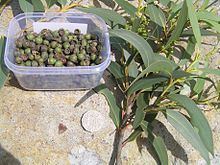Rank Species | ||
 | ||
Similar Eucalyptus burgessiana, Eucalyptus cretata, Eucalyptus copulans, Eucalyptus consideniana, Eucalyptus cunninghamii | ||
Eucalyptus langleyi, commonly known as Green Mallee Ash, Nowra Mallee, Nowra Mallee Ash or Albatross Mallee is an endangered Eucalyptus species native to south-eastern New South Wales, Australia. It grows in shallow standstone based soil in cool moderate rainfall areas.
Contents
Conservation Status
Eucalyptus langleyi has a conservation code of 2V according to Briggs & Leigh 1996. It is listed on Schedule: 2 of the 'NSW Threatened Species Conservation Act 1995' as a vulnerable species and is also listed under the 'Commonwealth Environment Protection and Biodiversity Conservation Act 1999' as vulnerable. The species occurs in the recently declared Parma Creek Nature Reserve where it was first identified as a new species by Laurence Langley, at the eastern end of the Nowra - Braidwood road (Main Road No. 92). National Conservation Status and Conservation status in NSW: Vulnerable
Description
Eucalyptus langleyi is a Mallee to 5-6m high. Bark is smooth, it can vary from a brownish grey, dark green or light pink that sheds in long ribbons. Young shoots prominently 4-winged. Juvenile leaves glossy green, broad-lanceolate to ovate. Adult leaves are disjunct, lanceolate, acuminate, sometimes oblique, coriaceous, glossy green, 8 – 18 cm long, 1.8 – 4 cm wide; petioles 8 – 18 mm long, winged, wings decurrent with wings on twigs; lateral veins obscure, anastomosing, at 10-20 degrees to midrib: intramarginal vein obscure, leave margin prominently thickened. Umbellasters axillary, 7 - 11 flowered; peduncles broadly winged, 8 – 12 mm long, to 7 mm wide apically; pedicels 0 –2 mm long, angular. Mature buds irregularly pyriform, rugose, 11 – 14 mm long, 4 – 6 mm diam.; calyptra less than ¼ as long as hypanthium, hemispherical, very broadly obtuse. Stamens all fertile; filaments inflexed into hypanthium in bud; anthers dorsifixed, versatile, reniform, dehiscing through confluent slits. Fruits cup-shaped, 3- or 4-locular, sometimes apically constricted, 8 – 10 mm long, 8 – 10 mm in diameter, sometimes with 1-3 vertical ridges; calyptra scar a narrow grove around hypanthium, stemonophore 0.5 – 1 mm wide, flat ultimately depressed to meet disc; disc enclosed, flat 1 - 1.5 mm wide; valves enclosed, tips often exserted. Seeds dull, grey brown angular, reniform, to 2.5 mm long; chaff similar, smaller. E. langleyi differs from E. burgessiana (apparent sister species) in the ovate juvenile leaves, the broader adult leaves (<2 5mm wide in the latter), larger buds (7–10 mm long, 3–4 mm wide in the latter), and the distinctly winged shoots.
Distribution
The species has been identified at approximately 25 sites, several of which contain several hundred plants. The total population is estimated at 2,300 plants. The first identified plants were located to the South-West of HMAS Albatross on the Nowra - Braidwood road (Main Road No.92) near Parma Creek and are located within the Parma Creek Nature Reserve, gazetted in January 2001. The main occurrence of the Albatross Mallee is to the south-west of Nowra as far as Yarramunmun Creek and on rocky outcrops near Tomerong - Yerriyong area. A very small population is found to the north of the Shoalhaven River in the Bomaderry Creek Regional Park. The total area of distribution is in an area of approximately 12 kilometres by 4 kilometres.
Ecology
Almost all stands of E. langleyi occur between 130 and 250 metres above sea level. All occurrences are on Nowra Sandstone, in shrubland on poorly-drained, shallow, sandstone-based, sandy soils. The larger populations of the species are associated with broad areas of shallow rock or rocky surface with few trees.
